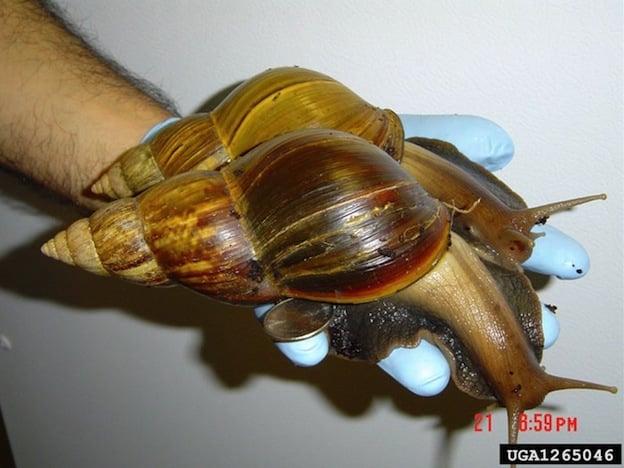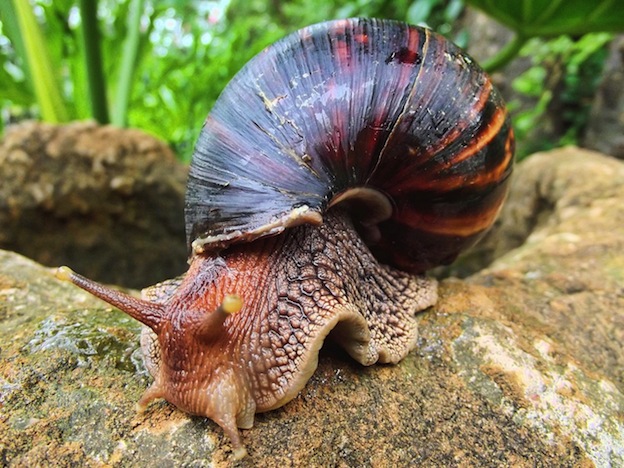Giant African Land Snail Giant African Land Snail Easy Draw
Giant African Land Snail

Photo taken by Sonel.SA
Achatina fulica
The Giant African Land Snail is one of the largest terrestrial gastropods. They have a light to dark brown shells with vertical stripes of a darker shade of brown on them.
They have an average lifespan of about 5-7 years. When they have enough food, and the weather is satisfactory, they tend to live much longer. Some of them have been known to live up to 10 years.
The "Achatina fulica" is one of the most invasive species in the world and the United States Department of Agriculture consider it as one of the most damaging species for the agriculture and crops in the country. It is known to eat at least 500 different species of plants.
This species is on the list of the 100 most harmful invasive alien species in the world, but Achatina fulica does not seem to surrender. This snail that stands out for its large size has easily adapted to life in regions outside its natural habitat and is considered one of the biggest land snails.
Class: Gastropoda
Family: Achatinidae
Genus: Achatina
Description
The shell of the giant African snail reaches up to 7.8 inches in length and 2.7-3.9 inches in height. An adult weighs about 32 grams. The body has two short tentacles and two long ones that have the eyes.
The shell has an appearance conical and narrow, with 7 to 9 spirals visible on its surface. The color is not always the same; it depends on the environmental conditions of the site where the snail dwells. It is usually slightly dark brown or reddish with yellowish vertical stripes. The opening is relatively small.
An important part of the anatomy of this snail is a structure in the mouth similar to a tongue, which is called the radula. It has small teeth that allow snails to scrap the food before eating it.
They have a "muscular foot" that helps them move releasing a mucus while they move to reduce friction and avoid damage to their tissues.
The shell is the location where the Giant African Land Snail takes refuge from predators. They will also spend time inside of their shells when the temperatures begin to dip too low at night for their comfort.

Image Courtesy: Roberta Zimmerman, USDA APHIS, Bugwood.org
Distribution and habitat
Although native to Africa, from Mozambique to Kenya and Somalia in addition to the nearby islands, this species has been introduced to many parts of the world over time and today can be found naturally in African countries such as Ghana, Ivory Coast, and Morocco. However, it lives now in Hawaii, Australia, islands of the Caribbean, islands, and regions of Asia, China, Bangladesh, Japan, Indonesia, Sri Lanka, Vietnam, Malaysia, Philippines, New Zealand, Samoa, Papua New Guinea, Fiji, and Vanuatu. In conclusion, the Giant African snail now dwells on all continents except Antarctica.
This snail thrives where the climate is hot and humid. In Africa, it lives along the edges of forests but can live on the banks of rivers and streams, shrublands, agricultural areas, plantations, gardens, wetlands and in various urban sites. It is capable of living in temperate climates too.
The Giant African Snails have been introduced in recent years to several locations and seem to have adapted extremely well. These areas include among others, the Caribbean and some Pacific islands. They often end up in unwanted places due to people transporting them, either as pet trade or inadvertently.
It is illegal to have one of them as a pet in the United States because they are one of the most invasive species in the world and they have produced extensive damage to crops in states like Florida, Georgia or Idaho.
Although some people may think it is no big deal, they can deposit a lot of eggs, up to 200 every time they deliver a batch, and this can happen in a short span of time. Then, soon can appear many munching around and damaging essential crops for humans. Some people turn them loose to get rid of them, and that is where the real trouble starts.
Feeding
This herbivore does not discriminate between living or dead plant matter. It has such an enormous appetite that it feeds on more than 500 types of plants, including those farmed by humans.
The Giant African Snail eats leaves, flowers, fruits, stems, barks, wood, seeds, grains, nuts, seaweed and even lichens, fungi and other snails. Economically valuable crops for humans such as cauliflower, cocoa, papaya, peanut, cassava, banana and many other vegetables often become food for the giant African snail.
They also need calcium to keep and grow hard shells, so they will consume more some types of plants to get the calcium they require. When they aren't able to get enough calcium in their diet from plants, they may feed on bones from carcasses, sand or small stones to get it.
Behavior
Achatina fulica is mostly active during the night, and during the day it remains dormant, often buried beneath the ground to stay safe from predators. It is not a social species. On the contrary, it lives all its life alone; Not even after laying eggs, it establishes any bond with its offspring.
Besides the USDA, several state governments like Idaho, Georgia, and Florida among others have listed this species as highly invasive and set controls to avoid their proliferation. The global invasive species database, have listed the Achatina fulica in the top 100 of their rank and associations like invasive.org have made similar warnings.
The Giant African Land Snails don't seem to interact with each other except for when they are going to mate. They don't produce any sounds, and they spend their time moving, eating, and resting.
They are considered to be active between 9 C and 29 C degrees, but they can survive above 2 C degrees by hibernating inside of their shell during the colder months. During this time, they can slow down their metabolism, so they don't need to eat or move during that period. They can remain inside of the shell for several months before they emerge again.
Sometimes, these snails estivate in the summer months to avoid the hot conditions. They can keep their moist by creating a barrier with a thin layer of mucus that their bodies create. In the case of severe drought, this process can take as long as three years.

Giant African Land Snail / Photo taken by Sonel.SA
Reproduction
The Giant African Land Snails are hermaphrodite which means that they have the reproduction organs for both males and females, so they have the capability to self-fertilize, but they do not usually do it. They mate in the "traditional way." However, sometimes young or immature snails only produce spermatozoa, while adults can also produce eggs.
In the pre-copulation stage, both snails approach and one of them locate behind the other and position above the shell. If the one underneath accepts it, it moves back, and the top snail begins copulation to transfer sperm and fertilize the eggs of its mate. In the case of snails of similar size, both can fertilize the eggs of the other simultaneously. Coupling usually takes place during the night.
About 8-20 days after intercourse, the snail puts between 100 and 500 eggs in a nest beneath the ground or between rocks and vegetation. Laying occurs every 2 or 3 months. Eggs hatch after 11-15 days, but the offspring do not receive any care from the parents.
They don't have a defined breeding period, and on average they lay 5-6 clutches of eggs per year, containing on average 200 eggs per clutch if there are the right conditions. Therefore, delivering close to 1,200 eggs per year and with a hatch success probability of 90%, this species can quickly become a pest.
The giant snail is not a threatened species.
Predators
The natural predators of this species are caterpillars, ground beetles, other species of snails, and many types of vertebrates. This said, nature doesn't limit predators and mammals such as the gray fox from praying on this snail as well.
Threats and conservation
The species is one of the most dangerous pests in agriculture and one of the least wanted animals, as it can transmit various diseases to both animals and humans given the parasites it harbors.
For a long time, people have implemented different strategies for the management and control of Achatina fulica populations. In some countries, it is illegal to own these snails because of the danger they represent. In contrast, they are sometimes caught for human consumption, although this practice is hazardous to health.
Sources:
https://en.wikipedia.org/wiki/Lissachatina_fulica
https://www.mapama.gob.es/es/biodiversidad/temas/conservacion-de-especies/achatina_fulica_2013_tcm7-307127.pdf
https://www.iucngisd.org/gisd/species.php?sc=64
https://animaldiversity.org/accounts/Achatina_fulica/
EarthPreview Publishing © 2020.
Source: https://www.snail-world.com/african-giant-snail/
0 Response to "Giant African Land Snail Giant African Land Snail Easy Draw"
Post a Comment